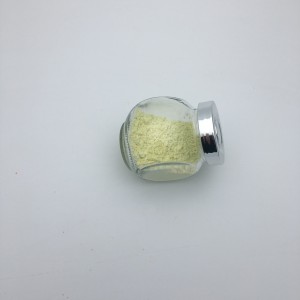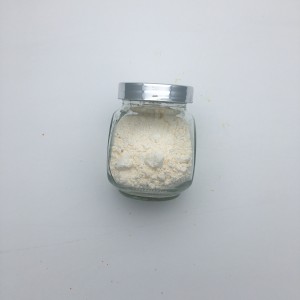Cerium oxide, Molecular formula is CeO2, Chinese alias: Cerium(IV) oxide, molecular weight: 172.11500. It can be used as polishing material, catalyst, catalyst carrier (assistant), ultraviolet absorber, fuel cell electrolyte, automotive exhaust absorber, Electroceramics, etc

Chemical property
At the temperature of 2000 ℃ and the pressure of 15 MPa, Cerium(III) oxide can be obtained by hydrogen reduction of cerium oxide. When the temperature is free at 2000 ℃, and the pressure is free at 5 MPa, the cerium oxide is slightly yellow, slightly red, and pink.
Physical property

Pure products are white heavy powder or cubic crystals, while impure products are light yellow or even pink to reddish brown (due to the presence of trace amounts of lanthanum, praseodymium, etc.).
Density 7.13g/cm3, melting point 2397 ℃, boiling point 3500 ℃..
Insoluble in water and alkali, slightly soluble in acid.
Toxic, Median lethal dose (rat, oral) is about 1g/kg.
Production method
The production method of cerium oxide is mainly oxalic acid precipitation, that is, taking cerium chloride or Cerium nitrates solution as raw material, adjusting the Ph value to 2 with oxalic acid, adding ammonia to precipitate Cerium oxalate, heating, maturing, separating, washing, drying at 110 ℃, and burning at 900~1000 ℃ to form cerium oxide.
CeCl2+H2C2O4+2NH4OH → CeC2O4+2H2O+2NH4Cl
Application
Oxidizing agents. Catalysts for Organic reaction. Use rare earth metal standard samples for steel analysis. Redox titration analysis. Discolored glass. Glass enamel sunshade. Heat resistant alloy.
Used as an additive in the glass industry, as a grinding material for plate glass, and also as a UV resistant agent in cosmetics. At present, it has been expanded to the grinding of glasses, optical lenses, and picture tubes, playing a role in decolorization, clarification, UV absorption of glass, and absorption of electronic lines.
Rare earth polishing effect
Rare earth polishing powder has the advantages of fast polishing speed, high smoothness, and long service life. Compared with traditional polishing powder – iron red powder, it does not pollute the environment and is easy to remove from the adhered object. Polishing the lens with cerium oxide polishing powder takes one minute to complete, while using iron oxide polishing powder takes 30-60 minutes. Therefore, rare earth polishing powder has the advantages of low dosage, fast polishing speed, and high polishing efficiency. And it can change the polishing quality and operating environment. Generally, rare earth glass polishing powder mainly uses cerium rich oxides. The reason why cerium oxide is an extremely effective polishing compound is because it can simultaneously polish glass through both chemical decomposition and mechanical friction. Rare earth cerium polishing powder is widely used for polishing cameras, camera lenses, television tubes, glasses, etc. At present, there are dozens of rare earth polishing powder factories in China, with a production scale of over ten tons. Baotou Tianjiao Qingmei Rare Earth Polishing Powder Co., Ltd., a Sino foreign joint venture, is currently one of the largest rare earth polishing powder factories in China, with an annual production capacity of 1200 tons and products sold domestically and internationally.
Glass decolorization
All glass contains iron oxide, which can be brought into the glass through raw materials, sand, limestone, and broken glass in glass ingredients. There are two forms of its existence: one is divalent iron, which turns the glass color into dark blue, and the other is trivalent iron, which turns the glass color into yellow. Discoloration is the oxidation of divalent iron ions into trivalent iron, because the color intensity of trivalent iron is only one tenth of that of divalent iron. Then add a toner to neutralize the color to a light green color.
The rare earth elements used for glass decolorization are mainly cerium oxide and neodymium oxide. Replacing the traditional white arsenic decolorizing agent with rare earth glass decolorizing agent not only improves efficiency, but also avoids the pollution of white arsenic. Cerium oxide used for glass decolorization has advantages such as stable high-temperature performance, low price, and no absorption of visible light.
Glass coloring
Rare earth ions have stable and bright colors at high temperatures, and are used to blend into the material to manufacture various colored glasses. Rare earth oxides such as neodymium, praseodymium, erbium, and cerium are excellent glass colorants. When transparent glass with rare earth colorants absorbs visible light with wavelengths ranging from 400 to 700 nanometers, it exhibits beautiful colors. These colored glass can be used to make indicator lampshades for aviation and navigation, various transportation vehicles, and various high-end artistic decorations.
When neodymium oxide is added to sodium calcium glass and Lead glass, the color of the glass depends on the thickness of the glass, the content of neodymium and the intensity of the light source. Thin glass is light pink, and thick glass is blue purple. This phenomenon is called neodymium dichroism; Praseodymium oxide produces a green color similar to chromium; Erbium(III) oxide is pink when used in Photochromism glass and crystal glass; The combination of cerium oxide and titanium dioxide makes the glass yellow; Praseodymium oxide and neodymium oxide can be used for praseodymium neodymium black glass.
Rare earth clarifier
Using cerium oxide instead of traditional arsenic oxide as a glass clarifying agent to remove bubbles and trace colored elements has a significant effect on the preparation of colorless glass bottles. The finished product has white crystal fluorescence, good transparency, and improved glass strength and heat resistance. At the same time, it also eliminates the pollution of arsenic to the environment and glass.
In addition, adding cerium oxide to daily glass, such as building and automotive glass, crystal glass, can reduce the transmittance of ultraviolet light, and this use has been promoted in Japan and the United States. With the improvement of quality of life in China, there will also be a good market. Adding neodymium oxide to the glass shell of a picture tube can eliminate the dispersion of red light and increase clarity. Special glasses with rare earth additions include lanthanum glass, which has high refractive index and low dispersion characteristics, and is widely used in the manufacturing of various lenses, advanced cameras, and camera lenses, especially for high-altitude photography devices; Ce radiation proof glass, used for Car glass and TV glass shell; Neodymium glass is used as laser material and is the most ideal material for giant lasers, mainly used for controlled Nuclear fusion devices
Post time: Jul-06-2023